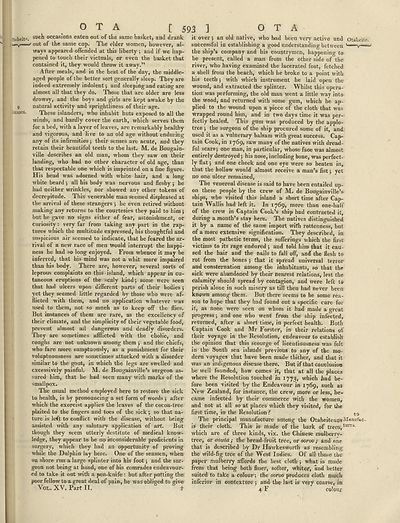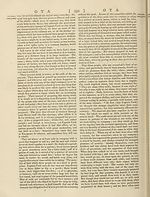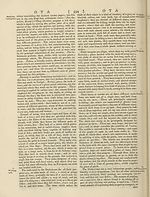Encyclopaedia Britannica > Volume 15, NIC-PAR
(669) Page 593
Download files
Complete book:
Individual page:
Thumbnail gallery: Grid view | List view

OTA [ 593 ] OTA
‘iti tdbcitp. 8Uch occasions eaten out of the same basket* and drank
v —y—< out of the same cup. The elder women, however, al-
Avays appeared offended at this liberty ; and if we hap¬
pened to touch their victuals, or even the basket that
contained it, they would throw it away.”
After meals, and in the heat of the day, the middle-
aged people of the better sort generally sleep. They are
indeed extremely indolent”, and sleeping and eating are
almost all that they do. Those that are older are less
drowsy, and the boys and girls are kept awake by the
9 natural activity and sprightliness of their age.
iseases. These islanders, who inhabit huts exposed to all the
winds, and hardly cover the earth, which serves them
for a bed, with a layer of leaves, are remarkably healthy
and vigorous, and live to an old age without enduring
any of its infirmities j their senses are acute, and they
retain their beautiful teeth to the last. M. de Bougain¬
ville describes an old man, whom they saw on their
landing, who had no other character of old age, than
that respectable one which is imprinted on a fine figure.
H is bead was adorned with white hair, and a long
white beard ”, all his body was nervous and fleshy j he
had neither wrinkles, nor showed any other tokens of
decrepitude. This venerable man seemed displeased at
the arrival of these strangers $ he even retired without
making any returns to the courtesies they paid to him j
Init he gave no signs either of fear, astonishment, or
Curiosity: very far from taking any part in the rap¬
tures which the multitude expressed, his thoughtful and
suspicious air seemed to indicate, that he feared the ar¬
rival of a new race of men Would interrupt the happi¬
ness he had so long enjoyed. From whence it may be
inferred, that his mind was not a whit more impaired
than his body. There are, however, several sorts of
leprous complaints on this island, which appear in cu¬
taneous eruptions of the scaly kind; some were seen
that had ulcers upon different parts of their bodies ;
yet they seemed little regarded by those who were af¬
flicted with them, and no application whatever was
used to them, not so much as to keep off the flies.
But instances of them are rare, as the excellency of
their climate, and the simplicity of their vegetable food,
prevent almost ail dangerous and deadly disorders.
They are sometimes afflicted with the cholic, and
coughs are not unknown among them ; and the chiefs,
who fare more sumptuously, as a punishment for their
voluptuousness are sometimes attacked with a disorder
similar to the gout, in which the legs are swelled and
excessively painful. M. de Bougainville’s surgeon as¬
sured him, that he had seen many with marks of the
Smallpox.
The usual method employed here to restore the sick
to health, is by pronouncing a set form of words ; after
which the exorcist applies the leaves of the cocoa-tree
plaited to the fingers and toes of the sick; so that na¬
ture is left to conflict with the disease, without being
assisted with any salutary application of art. But
though they seem utterly destitute of medical know¬
ledge, they appear to be no inconsiderable proficients in
surgery, which they had an opportunity of proving
while the Dolphin lay here. One of the seamen, when
on shore run a large splinter into his foot; and the sur¬
geon not being at hand, one of his comrades endeavour¬
ed to take it out with a pen-knife : but after putting the
poor fellow to a great deal of pain, he was obliged to give
Vox. XV. Part II. *
it over; an old native, who had been very active and OtaLeite.
successful in establishing a good understanding between l——y—i~
the ship’s company and his countrymen, happening to
be present, called a man from the other side of the
river, who having examined the lacerated foot, fetched
a shell from the beach, which he broke to a point with
his teeth; with which instrument he laid open the
wound, and extracted the Splinter. Whilst this opera¬
tion was performing, the old man went a little way into
the wood, and returned with some gum, which he ap¬
plied to the wound upon a piece of the cloth that was
wrapped round him, and in two days time it was per¬
fectly healed. This gum was produced by the apple-
tree ; the surgeon of the ship procured some of it, and:
used it as a vulnerary balsam with great success. Cap¬
tain Cook, in 1769* saw many of the natives with dread¬
ful scars; one man, in particular, whose face was almost
entirely destroyed; his nose, including bone, was perfect¬
ly flat; and one cheek and one eye were so beaten in,
that the hollow would almost receive a man’s fist; yet
no one ulcer remained,
The venereal disease is said to have been entailed up¬
on these people by the crew of M. de Bougainville’s
ships, who visited this island a short time after Cap¬
tain Wallis had left it. In 1769, more than one-half
ot the crew in Captain Cook’s ship had contracted it,
during a month’s stay here. The natives distinguished
it by a name of the same import with rottenness, but
of a more extensive signification. They described, in
the most pathetic terms, the sufferings which the first
victims to its rage endured; and told him that it cau¬
sed the hair and the nails to fall off, and1 the flesh to
rot from the bones ; that it spread universal terror
and consternation among the inhabitants, so that the
sick were abandoned by their nearest relations, lest the
calamity should spread by contagion, and were left to
perish alone in such misery as till then had never been
known among them. But there seems to be some rea¬
son to hope that they had found out a specific cure for
it, as none were seen on whom it had made a great
progress; and one who went from the ship infected,
returned, after a short time, in perfect health. Both
Captain Cook and Mr Forster, in their relations of
their voyage in the Resolution, endeavour to establish
the opinion that this scourge of licentiousness was felt
in the South sea islands previous to any of the mo¬
dern voyages that have been made thither, and that it
was an indigenous disease there. But if that conclusion
be well founded, how comes it, that at all the places
where the Resolution touched in 1773, which had be¬
fore been visited by the Endeavour in 1769, such as
New Zealand, for instance, the crew, more or less, be¬
came infected by their commerce with the women,
and not at all so at places which they visited, for the
first time, in the Resolution ?
The principal manufacture among the Otahekeana
is their cloth. This is made of the bark of trees,tures-
which are of three kinds, vix. the Chinese mulberrv-
tree, or aoula ; the bread-fruit tree, or ooroo ; and one
that is described by Dr Hawkesworfh as resembling
the wild-fig tree of the West Indies. Of all these the
paper mulberry affords the best cloth ; what is made
from that being both finer, softer, whiter, and better
suited to take a colour; the ooroo produces cloth much
inferior in contexture; and the1 last is very coarse, in
4 F colour
‘iti tdbcitp. 8Uch occasions eaten out of the same basket* and drank
v —y—< out of the same cup. The elder women, however, al-
Avays appeared offended at this liberty ; and if we hap¬
pened to touch their victuals, or even the basket that
contained it, they would throw it away.”
After meals, and in the heat of the day, the middle-
aged people of the better sort generally sleep. They are
indeed extremely indolent”, and sleeping and eating are
almost all that they do. Those that are older are less
drowsy, and the boys and girls are kept awake by the
9 natural activity and sprightliness of their age.
iseases. These islanders, who inhabit huts exposed to all the
winds, and hardly cover the earth, which serves them
for a bed, with a layer of leaves, are remarkably healthy
and vigorous, and live to an old age without enduring
any of its infirmities j their senses are acute, and they
retain their beautiful teeth to the last. M. de Bougain¬
ville describes an old man, whom they saw on their
landing, who had no other character of old age, than
that respectable one which is imprinted on a fine figure.
H is bead was adorned with white hair, and a long
white beard ”, all his body was nervous and fleshy j he
had neither wrinkles, nor showed any other tokens of
decrepitude. This venerable man seemed displeased at
the arrival of these strangers $ he even retired without
making any returns to the courtesies they paid to him j
Init he gave no signs either of fear, astonishment, or
Curiosity: very far from taking any part in the rap¬
tures which the multitude expressed, his thoughtful and
suspicious air seemed to indicate, that he feared the ar¬
rival of a new race of men Would interrupt the happi¬
ness he had so long enjoyed. From whence it may be
inferred, that his mind was not a whit more impaired
than his body. There are, however, several sorts of
leprous complaints on this island, which appear in cu¬
taneous eruptions of the scaly kind; some were seen
that had ulcers upon different parts of their bodies ;
yet they seemed little regarded by those who were af¬
flicted with them, and no application whatever was
used to them, not so much as to keep off the flies.
But instances of them are rare, as the excellency of
their climate, and the simplicity of their vegetable food,
prevent almost ail dangerous and deadly disorders.
They are sometimes afflicted with the cholic, and
coughs are not unknown among them ; and the chiefs,
who fare more sumptuously, as a punishment for their
voluptuousness are sometimes attacked with a disorder
similar to the gout, in which the legs are swelled and
excessively painful. M. de Bougainville’s surgeon as¬
sured him, that he had seen many with marks of the
Smallpox.
The usual method employed here to restore the sick
to health, is by pronouncing a set form of words ; after
which the exorcist applies the leaves of the cocoa-tree
plaited to the fingers and toes of the sick; so that na¬
ture is left to conflict with the disease, without being
assisted with any salutary application of art. But
though they seem utterly destitute of medical know¬
ledge, they appear to be no inconsiderable proficients in
surgery, which they had an opportunity of proving
while the Dolphin lay here. One of the seamen, when
on shore run a large splinter into his foot; and the sur¬
geon not being at hand, one of his comrades endeavour¬
ed to take it out with a pen-knife : but after putting the
poor fellow to a great deal of pain, he was obliged to give
Vox. XV. Part II. *
it over; an old native, who had been very active and OtaLeite.
successful in establishing a good understanding between l——y—i~
the ship’s company and his countrymen, happening to
be present, called a man from the other side of the
river, who having examined the lacerated foot, fetched
a shell from the beach, which he broke to a point with
his teeth; with which instrument he laid open the
wound, and extracted the Splinter. Whilst this opera¬
tion was performing, the old man went a little way into
the wood, and returned with some gum, which he ap¬
plied to the wound upon a piece of the cloth that was
wrapped round him, and in two days time it was per¬
fectly healed. This gum was produced by the apple-
tree ; the surgeon of the ship procured some of it, and:
used it as a vulnerary balsam with great success. Cap¬
tain Cook, in 1769* saw many of the natives with dread¬
ful scars; one man, in particular, whose face was almost
entirely destroyed; his nose, including bone, was perfect¬
ly flat; and one cheek and one eye were so beaten in,
that the hollow would almost receive a man’s fist; yet
no one ulcer remained,
The venereal disease is said to have been entailed up¬
on these people by the crew of M. de Bougainville’s
ships, who visited this island a short time after Cap¬
tain Wallis had left it. In 1769, more than one-half
ot the crew in Captain Cook’s ship had contracted it,
during a month’s stay here. The natives distinguished
it by a name of the same import with rottenness, but
of a more extensive signification. They described, in
the most pathetic terms, the sufferings which the first
victims to its rage endured; and told him that it cau¬
sed the hair and the nails to fall off, and1 the flesh to
rot from the bones ; that it spread universal terror
and consternation among the inhabitants, so that the
sick were abandoned by their nearest relations, lest the
calamity should spread by contagion, and were left to
perish alone in such misery as till then had never been
known among them. But there seems to be some rea¬
son to hope that they had found out a specific cure for
it, as none were seen on whom it had made a great
progress; and one who went from the ship infected,
returned, after a short time, in perfect health. Both
Captain Cook and Mr Forster, in their relations of
their voyage in the Resolution, endeavour to establish
the opinion that this scourge of licentiousness was felt
in the South sea islands previous to any of the mo¬
dern voyages that have been made thither, and that it
was an indigenous disease there. But if that conclusion
be well founded, how comes it, that at all the places
where the Resolution touched in 1773, which had be¬
fore been visited by the Endeavour in 1769, such as
New Zealand, for instance, the crew, more or less, be¬
came infected by their commerce with the women,
and not at all so at places which they visited, for the
first time, in the Resolution ?
The principal manufacture among the Otahekeana
is their cloth. This is made of the bark of trees,tures-
which are of three kinds, vix. the Chinese mulberrv-
tree, or aoula ; the bread-fruit tree, or ooroo ; and one
that is described by Dr Hawkesworfh as resembling
the wild-fig tree of the West Indies. Of all these the
paper mulberry affords the best cloth ; what is made
from that being both finer, softer, whiter, and better
suited to take a colour; the ooroo produces cloth much
inferior in contexture; and the1 last is very coarse, in
4 F colour
Set display mode to:
![]() Universal Viewer |
Universal Viewer | ![]() Mirador |
Large image | Transcription
Mirador |
Large image | Transcription
Images and transcriptions on this page, including medium image downloads, may be used under the Creative Commons Attribution 4.0 International Licence unless otherwise stated. ![]()
| Encyclopaedia Britannica > Encyclopaedia Britannica > Volume 15, NIC-PAR > (669) Page 593 |
|---|
| Permanent URL | https://digital.nls.uk/192590395 |
|---|
| Attribution and copyright: |
|
|---|
| Shelfmark | EB.11 |
|---|---|
| Description | Ten editions of 'Encyclopaedia Britannica', issued from 1768-1903, in 231 volumes. Originally issued in 100 weekly parts (3 volumes) between 1768 and 1771 by publishers: Colin Macfarquhar and Andrew Bell (Edinburgh); editor: William Smellie: engraver: Andrew Bell. Expanded editions in the 19th century featured more volumes and contributions from leading experts in their fields. Managed and published in Edinburgh up to the 9th edition (25 volumes, from 1875-1889); the 10th edition (1902-1903) re-issued the 9th edition, with 11 supplementary volumes. |
|---|---|
| Additional NLS resources: |
|

